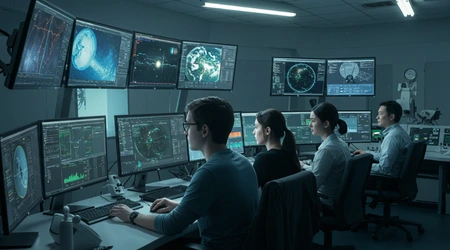How Astronomers Detect Planets They Can’t Even See

Astronomers detect planets they can’t even see by harnessing ingenious techniques that reveal hidden worlds through subtle cosmic clues.
Anúncios
In 2025, the search for exoplanets planets orbiting stars beyond our solar system has transformed our understanding of the universe.
With nearly 6,000 confirmed exoplanets, as reported by NASA’s Exoplanet Archive, scientists use advanced methods to uncover these distant worlds without ever glimpsing them directly.
This article dives into the cutting-edge techniques driving these discoveries, exploring how astronomers decode stellar signals to find planets that could harbor life.
Why do these invisible worlds matter? They hold the key to answering humanity’s ultimate question: Are we alone?
The quest to find exoplanets is a blend of precision, creativity, and technological prowess. From observing starlight dips to detecting stellar wobbles, astronomers employ methods like transit photometry, radial velocity, and microlensing.
These techniques, refined over decades, allow scientists to infer the presence of planets light-years away. Each method offers unique insights, painting a richer picture of alien worlds.
Let’s explore how astronomers detect planets they can’t even see, unraveling the science behind this cosmic detective work and its implications for life beyond Earth.
The Transit Method: Catching Planets in Starlight’s Shadow
When a planet crosses its star’s face, it blocks a tiny fraction of light, creating a detectable dip. This transit method, pioneered by NASA’s Kepler mission, is a cornerstone of exoplanet discovery.
By monitoring a star’s brightness over time, astronomers spot periodic dimming, signaling an orbiting planet. For example, the exoplanet Kepler-22b was found using this method, revealing a world in its star’s habitable zone.
Precision is critical in transit photometry. The James Webb Space Telescope (JWST), launched in 2021, has enhanced this technique by analyzing starlight filtered through exoplanet atmospheres.
This spectroscopy reveals chemical compositions, like methane or water vapor, hinting at potential habitability. In 2025, JWST’s observations of K2-18b detected possible biosignatures, sparking excitement about life’s prospects.
Yet, transits demand patience. Planets must align perfectly with our line of sight, and multiple observations confirm their orbits.
++ Could Alien Life Be Based on Something Other Than Carbon?
This method excels at finding close-in planets but struggles with distant ones, pushing astronomers to combine it with other techniques for a fuller picture.
The method’s strength lies in its scalability. Kepler and TESS (Transiting Exoplanet Survey Satellite) have surveyed thousands of stars, amassing vast datasets.
These missions show that roughly one in five Sun-like stars hosts an Earth-sized planet in its habitable zone, a statistic that fuels optimism about finding life.
However, transits aren’t foolproof. False positives, like binary star systems, can mimic planetary signals. Astronomers cross-check with ground-based telescopes to ensure accuracy, refining their cosmic census with each new discovery.

Radial Velocity: Listening to a Star’s Wobble
Stars don’t sit still when planets orbit them. The gravitational tug of a planet causes its star to wobble slightly, detectable through shifts in starlight’s wavelength.
This radial velocity method, used since the 1990s, helped discover the first exoplanet around a Sun-like star, 51 Pegasi b. By measuring Doppler shifts, astronomers detect planets they can’t even see with remarkable precision.
The method shines for massive planets close to their stars, like hot Jupiters. Instruments like HARPS (High Accuracy Radial velocity Planet Searcher) can detect velocity shifts as small as a meter per second.
Imagine a star wobbling like a dancer swaying to a planet’s rhythm an apt analogy for this gravitational choreography.
Also read: What the Discovery of Earth-Like Planets Means for Humanity
Radial velocity complements transit observations. While transits reveal a planet’s size, this method estimates its mass, offering clues about composition. For instance, a heavy planet like HD 189733 b suggests a gas giant, not a rocky world.
Challenges persist, though. Stellar activity, like sunspots, can mimic planetary signals, requiring careful analysis.
In 2025, advancements in spectrographs have improved detection, but distant planets with long orbits remain elusive, pushing astronomers to refine their tools.
Combining radial velocity with transits is powerful. For example, the exoplanet Proxima Centauri b, orbiting the closest star to Earth, was confirmed using this method, sparking hope for future studies of nearby worlds.
Gravitational Microlensing: A Cosmic Magnifying Glass
Microlensing offers a unique way to find planets far from their stars. When a foreground star passes in front of a distant one, its gravity bends light, amplifying the background star’s brightness.
A planet orbiting the foreground star can create additional brightness spikes, revealing its presence. Astronomers detect planets they can’t even see through these fleeting events.
This method excels at finding distant planets, like OGLE-2016-BLG-0007, a super-Earth with a Jupiter-like orbit. In 2025, the Korea Microlensing Telescope Network (KMTNet) reported that super-Earths are common in wide orbits, suggesting diverse planetary systems.
Microlensing is rare and unpredictable, requiring constant monitoring of millions of stars. Imagine it like catching a firefly’s flash in a dark field brief but revealing.
The method’s strength is its sensitivity to low-mass planets far from their stars, unlike transit or radial velocity.
Read more: Detecting Life Through Methane and Oxygen Signatures in Exoplanets
However, microlensing events are one-time occurrences, making follow-up observations difficult.
Astronomers rely on statistical models to infer planet populations, as seen in KMTNet’s surveys, which estimate one super-Earth per three stars.
The Roman Space Telescope, set to launch by 2027, will enhance microlensing’s reach, potentially uncovering thousands more planets. This method’s ability to probe distant systems makes it a vital tool in the exoplanet hunt.
Direct Imaging: The Challenge of Seeing the Unseen
Direct imaging is the holy grail of exoplanet detection, aiming to photograph planets directly. Astronomers detect planets they can’t even see by blocking starlight with coronagraphs, revealing faint planetary glows.
In 2025, JWST directly imaged a Saturn-sized planet around TWA 7, a breakthrough for the field.
This method suits young, massive planets far from their stars, which emit detectable infrared light. For example, the Beta Pictoris system’s planets were captured this way, offering insights into their atmospheres.
Direct imaging faces immense challenges. Stars are billions of times brighter than planets, like trying to spot a candle beside a spotlight. Advanced optics and image processing are crucial, with JWST leading the charge in 2025.
Future telescopes, like the Habitable Worlds Observatory (HWO), planned for the 2050s, aim to image Earth-like planets. These missions could detect biosignatures, like oxygen or methane, revolutionizing the search for life.
Despite its difficulties, direct imaging offers unparalleled detail. By analyzing reflected light, astronomers can study atmospheric compositions, bringing us closer to identifying habitable worlds.
Biosignatures: Hunting for Signs of Life
The ultimate goal of exoplanet detection is finding life. Astronomers detect planets they can’t even see by analyzing atmospheres for biosignatures gases like dimethyl sulfide (DMS).
In 2025, JWST’s observations of K2-18b suggested DMS, a molecule linked to microbial life on Earth.
Spectroscopy is key. As starlight passes through a planet’s atmosphere, gases absorb specific wavelengths, creating a chemical fingerprint. JWST’s precision revealed methane and carbon dioxide on K2-18b, hinting at a water-rich world.
Skepticism remains. DMS could arise from non-biological processes, like volcanic activity. In 2025, follow-up studies questioned K2-18b’s biosignature claims, urging caution.
Consider the exoplanet TRAPPIST-1e, a rocky world in its star’s habitable zone. Its atmosphere, if detected, could reveal water vapor or oxygen, key life indicators. Future observations will test these possibilities.
The search for biosignatures is a marathon. Combining multiple detection methods with advanced telescopes will refine our understanding, potentially confirming life’s existence within decades.
The Future of Exoplanet Detection

The next decade promises transformative advancements. Astronomers detect planets they can’t even see with ever-improving tools, from JWST to the upcoming Roman Space Telescope. These missions will expand our catalog of exoplanets, focusing on Earth-like worlds.
Machine learning is revolutionizing data analysis. Algorithms now sift through vast datasets, identifying subtle planetary signals missed by human eyes. In 2025, AI enhanced TESS’s discovery of 618 confirmed exoplanets.
International collaboration drives progress. Projects like the Giant Magellan Telescope (GMT) will study exoplanet atmospheres, complementing space-based efforts. These telescopes aim to find Earth analogs by the 2030s.
Public interest fuels funding. Imagine a child gazing at the stars, inspired to become an astronomer—this curiosity drives missions like HWO, targeting habitable planets.
The question remains: Will we find life? As technology advances, astronomers detect planets they can’t even see with growing confidence, bringing us closer to answering this cosmic riddle.
Table: Exoplanet Detection Methods (2025)
| Method | How It Works | Strengths | Limitations |
|---|---|---|---|
| Transit Photometry | Measures starlight dips from planetary transits | Finds planet sizes, orbits; scalable | Requires precise alignment; false positives |
| Radial Velocity | Detects star wobble via Doppler shifts | Estimates planet mass; precise for close-in planets | Stellar activity interference; long orbits hard |
| Gravitational Microlensing | Uses light bending to detect planets | Finds distant, low-mass planets | Rare, non-repeatable events |
| Direct Imaging | Photographs planets by blocking starlight | Reveals atmospheres; suits young planets | Star brightness overwhelms; technically hard |
Conclusion: A Universe Full of Possibilities
The search for exoplanets is a testament to human ingenuity. Astronomers detect planets they can’t even see by decoding subtle stellar signals, revealing worlds that challenge our imagination.
From the transit method’s precision to microlensing’s cosmic lens, each technique brings us closer to understanding our place in the cosmos.
The 2025 discovery of possible biosignatures on K2-18b, though debated, underscores the stakes: we’re on the cusp of finding life beyond Earth.
As telescopes like JWST and future missions like HWO push boundaries, the dream of discovering habitable worlds feels within reach.
Picture a planet like Earth, orbiting a distant star, teeming with life perhaps a microbial ocean or alien forests. This vision drives astronomers to refine their methods, blending science with wonder.
The universe is vast, and each new planet discovered is a step toward answering whether we’re alone. With every signal detected, astronomers detect planets they can’t even see, and humanity’s cosmic journey grows richer.
Frequently Asked Questions
How do astronomers ensure detections are real planets?
They cross-check data with multiple methods, like combining transit and radial velocity, to rule out false positives like binary stars.
What makes a planet potentially habitable?
A planet needs liquid water, a stable atmosphere, and a suitable distance from its star, as seen in the habitable zone.
Can direct imaging find Earth-like planets?
Not yet. Current tech, like JWST, images large, young planets, but future telescopes like HWO aim for Earth analogs.
Why is DMS a biosignature?
On Earth, DMS is produced by microbes like phytoplankton. Its presence on exoplanets, like K2-18b, suggests possible life.
How long until we confirm alien life?
It depends on luck and tech. Advanced telescopes by the 2030s may detect unmistakable biosignatures, but it’s a gradual process.
